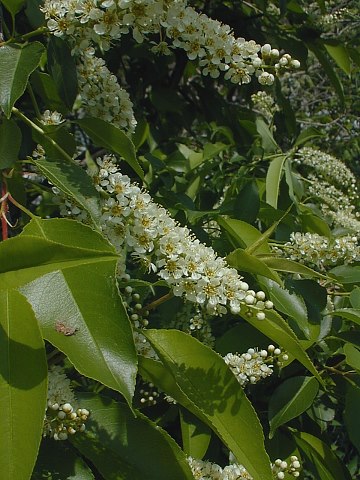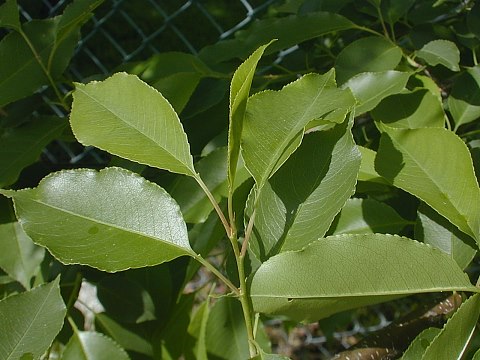Description: This is a woody tree up to 80' tall. It has a central trunk at the base and a crown of leafy branches that is longer than wide. The tips of growing branches are green and glabrous, but they soon become reddish brown and woody. The bark of larger branches is relatively smooth and reddish brown. The lenticels (air pores) of this bark are conspicuously white and horizontally flattened. On older trees, the coarse bark of the trunk becomes brown-black and rough-textured. The smaller branches and twigs produce alternate leaves. The blades of these leaves are up to 6" long and 2" across; they are ovate, narrowly ovate, or lanceolate-ovate in shape and finely serrated along their margins. The tiny teeth of these margins curve inward. The upper surface of each leaf is green and glabrous, while the lower surface is light green. The lower surface is usually glabrous, but sometimes there are fine hairs along the central vein. The tip of each leaf blade is slender and acute, while its base is rounded or wedge-shaped. The slender petioles of the leaves are up to 1" long; each petiole has a pair of tiny nectaries near the leaf blade.

Elongated racemes of flowers are produced from short leafy branches; they are ascending, widely spreading, or descending (often the latter). Each raceme is 4-6" long and densely packed with flowers (see Close-up of Raceme). Each flower is ½" across, consisting of 5 white petals, 5 green sepals, 15-22 stamens, and a central pistil with a flattened stigma. The petals are obovate in shape and much longer than the sepals. The blooming period occurs from late spring to early summer and lasts about 2-3 weeks. Each flower is replaced by a globoid fleshy drupe about ¼" (6 mm.) across. Immature drupes are green, but they become dark red and finally purple-black at maturity during the fall. Each drupe contains a single stone with a smooth surface. The flesh of a mature drupe is sweet and slightly bitter. The root system consists of woody taproot. This tree spreads by reseeding itself.
Cultivation: Wild Black Cherry is fast-growing and adaptable. It prefers full sun to light shade, moist to slightly dry conditions, and fertile soil containing loam, clay-loam, or some rocky material. Too much shade from larger canopy trees will stunt the growth of Wild Black Cherry or even kill it.
stunt the growth of Wild Black Cherry or even kill it.
Range & Habitat: The native Wild Black Cherry is common throughout Illinois; it occurs in every county (see Distribution Map). Habitats include deciduous woodlands (dominated by oak, basswood-maple, & others), open woodlands, woodland borders, savannas, limestone glades, fence rows, powerline clearances, vacant lots, and waste areas. Wild Black Cherry is a pioneer species that thrives on disturbance in wooded areas. It is one of the woody species that can invade prairies and meadows in the absence of fire.
Faunal Associations: The nectar and pollen of the flowers such pollinating insects as honeybees, bumblees, other long-tongued bees, Halictid bees (including green metallic bees), Andrenid bees (Andrena spp.), Syrphid flies, Tachinid flies, Calliphorid flies, other flies, butterflies, and various beetles (Robertson, 1929; Wilhelm & Rericha, 2017; Krombein et al., 1979; Lovell, 1915). Wild Black Cherry also has extra-floral nectaries that attract Halictid bees (Lasioglossum spp.), Andrenid bees (Andrena spp.), various flies, and ants (including Formica spp. & Crematogaster spp.); see Robertson (1929) and Wilhelm & Rericha, 2017. These nectaries exist to protect the leaves of this tree from some insects that feed on the leaves; this is because the ants may discover and attack them. Many insects feed destructively on various parts of Wild Black Cherry. This includes such species as the Cherry Leaf Beetle (Tricholochmaea cavicollis), Cherry Lace Bug (Corythucha pruni), larvae of the Wild Cherry Bud Gall Midge (Contarinia cerasiserotinae), Black Cherry Aphid (Myzus cerasi), Scurfy Bark Scale (Chionaspis furfura), larvae of an Argid sawfly (Sterictiphora serotina), larvae of the Cherry Casebearer Moth (Coleophora pruniella), larvae of the Cherry Scallop Moth (Rheumaptera prunivorata), larvae of the Cherry Dagger Moth (Acronicta hasta), and larvae of several butterflies, including the Spring Azure (Celastrina ladon), Coral Hairstreak (Satyrium titus), Red-spotted Purple (Limenitis arthemis astyanax), and Tiger Swallowtail (Papilio glaucus). The Insect Table provides more information about insects that have been observed to feed specifically on Wild Black Cherry. Among vertebrate animals, the fruits of Wild Black Cherry are very popular with many species of birds, including the Rose-breasted Grosbeak, Blue Jay, Song Sparrow, Evening Grosbeak, Red-winged Blackbird, Baltimore Oriole, Gray Catbird, Northern Mockingbird, Bobwhite Quail, Ruffed Grouse, Greater Prairie Chicken, Northern Flicker, Pileated Woodpecker, Downy Woodpecker, Veery, Grey-cheeked Thrush, Eastern Bluebird, American Robin, Eastern Kingbird, and Red-eyed Vireo. The Bird Table provides a more complete list of bird species that feed on these fruits. Mammals that feed on the fruits of this tree include the Gray Fox, American Red Fox, and American Black Bear. Some rodents, such as the Deer Mouse and White-footed Mouse, eat the fruits and gather their pits for long-term storage in their dens as a winter food source. White-tailed Deer sometimes browse on the leaves and twigs (Martin et al., 1951/1961; Sotala & Kirkpatrick, 1973; Hamilton, 1941; Beeman & Pelton, 1980). Wild Black Cherry functions as a roost tree for some species of bats, including the Hoary Bat (Lasiurus cinereus) and Northern Long-eared Bat (Myotis septentrionalis); see Shimp & Shimp (1982) and Johnson et al. (2009). In general, the value of Wild Black Cherry to wildlife is very high.
Photographic Location: Along a fence row behind the webmaster's apartment complex in Urbana, Illinois.

Comments: Some people regard Wild Black Cherry as weedy and aggressive, but its value to wildlife is exceptional. This is the largest native cherry in Illinois. The wood of this species is used in the construction of fine furniture. Wild Black Cherry should not be confused with the cultivated Black Cherry (Prunus avium), which has larger drupes (½" across or more) that are sold in supermarkets. This latter species is native to Eurasia; its flowers and fruits are arranged in short drooping umbels, rather than long racemes. Another native cherry in Illinois is Prunus virginiana (Choke Cherry). This species is a small tree or shrub up to 20' tall. The leaf margins of this species have pointed teeth that spread outward, rather than curving inward. As the common name suggests, the fruit of Chokecherry is astringent and bitter. Two other native species, Prunus pensylvanica (Pin Cherry) and Prunus pumila susquehanae (Sand Cherry), also produce cherry-like fruits. In Illinois, they are encountered primarily in sandy areas along Lake Michigan.